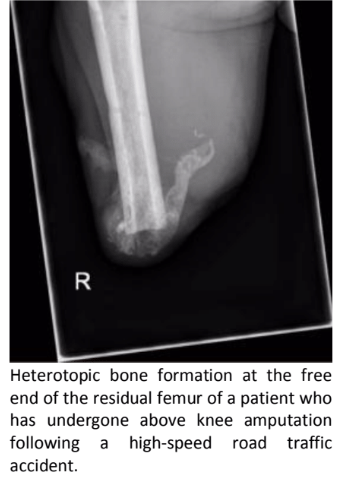Bone related problems
Get in touch
Bony prominences which chafe and rub in a prosthetic socket and heterotopic bone formation can cause significant problems after amputation. There are two main concerns:
- The shape of the free-end of the residual bone
- New bone growth (heterotopic bone)
The shape of the free-end of the residual bone can become a problem as the soft tissues mature over time and change shape. As swelling resolves and muscles atrophy, the shape of the residual limb can change quite significantly. Often this leads to a bony prominence either at the very end of the stump, or where it rubs in the socket. This is particularly common in trans-tibial amputees at the distal end of the tibia or over the head of the fibula.

Heterotopic bone formation may also occur. This results in the formation of new bone growth which occurs at the tip of the residual bone or along its length and may vary considerably in its extent. It is particularly common in patients who suffered a high energy injury (especially explosions, road traffic accidents etc).
Reshaping of the free end of the bone can usually be achieved by reopening the existing scars. The end of the bone may need to be bevelled or trimmed depending on the nature of the bony problem. If a bony prominence is causing issues within the socket, then we may need to extend the existing scar or create an additional scar to gain access.
Heterotopic ossification is much more varied in its presentation. If it is limited to the end of the bone it can usually be addressed by opening the existing scars. The surgery required is not dissimilar to revision of the free end of your residual bone. However, if it is much more extensive, it may require more surgical planning to determine the best approach and this may be accompanied by the need for more significant manipulation of the overlying soft tissues.
Pre and Post-op Management
Anaesthetic: Patients undergoing bony revision surgery of this kind will usually require a regional block (e.g. axillary or spinal anaesthetic) or a general anaesthetic. You can discuss your specific requirements with our anaesthetists before surgery.
Length of stay: This depends on the specific nature of the procedure performed in your case. Most bony revision can be performed as a daycase procedure. However, if there is very extensive bony resection it can ooze significantly and might require an overnight stay.
Pain control: Pain levels after surgery vary from one individual to the next. In general, pain levels after bony surgery settle after 24 48 hours and can be managed with simple opiates (e.g. Codeine or tramadol) taken orally for a few days. Discuss your specific requirements with your anaesthetist before discharge.
Wound care: Wound care after bony revision surgery is usually simple. You can shower immediately but should not soak your wounds in a bath for 2-3 weeks. Running water is fine. If you do shower, your dressings will get wet and will probably come off. Do not worry. We will supply you with adhesive dressings to replace them. Pat your wound(s) dry with clean tissue Heterotopic bone formation at the free end of the residual femur of a patient who has undergone above knee amputation following a high-speed road traffic accident. paper and leave your wound(s) exposed to the air for 15-30 minutes. Then apply a new adhesive dressing.
Rehabilitation: Although you do not need any specific rehabilitation exercises after this type of surgery, the shape of your residual limb will of course change, both temporarily and in the long-term. It is likely that you will be unable to use your standard socket immediately after surgery both to avoid problems with your new wound and because your residual limb will be swollen. Once your wounds have healed and any swelling has settled, you will need to have a new socket fitted to your residual limb.
